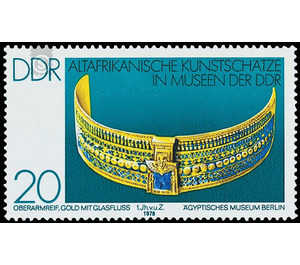Altafrikanische art treasures in museums of the GDR - Germany / German Democratic Republic 1978 - 20 Pfennig
Theme: Devices, Items & Instruments
| Country | Germany / German Democratic Republic |
| Issue Date | 1978 |
| Face Value | 20.00 |
| Color | yellow blue |
| Perforation | K 14 |
| Printing Type | Rotogravure 2 |
| Stamp Type | Postage stamp |
| Item Type | Stamp |
| Chronological Issue Number | 2074 |
| Chronological Chapter | GER-DDR |
| SID | 306923 |
| In 24 Wishlists | |
Old African Art Treasures in Museums of the GDR With pictures of Old African art shooters from GDR museums, the Ministry of Posts and Telecommunications of the German Democratic Republic publishes six multi-colored special postage stamps. Special cancellations from June 20 to August 19, 1978 Old-African art shooters in GDR museums The motifs of this special postage stamp issue reflect objects from the rich collections of the Egyptian Museum of the Karl Marx University Leipzig and the Egyptian Museum of the National Museums in Berlin in the exhibition "Africa in Antiquity - Art Treasures from Nubia and Sudan" organized by the Brooklyn Museum, NY, USA, with scientific support from the National Museums in Berlin, GDR, 1978/79. 20 Pfennig value: Oberarmreif, gold with glass flow, 1. Jh. V. Chr. u. Z. - Egyptian Museum Berlin The golden bracelet with rosette decoration was found in the pyramid of Queen Amanishakheto (late 1st century BCE) together with other jewelery on the northern cemetery of Meroe. Moroe was the later capital of the kingdom of Meroe, which dates from the 7th century BC. u. Z. until the 4th century BC u. Z. from Lower Nubia to at least the area of Khartoum extended. The two curved and connected by a hinge parts of the bracelet (height 3.2 cm, length 2 x 9.2 cm) are bordered by a braided band pattern. In five horizontal strips are shown in cellular fusion: a Uräenfries, teardrop-shaped patterns, diamonds, patch rosettes and two rows of squares standing on the top. Above the joint is a plate with the image of a temple gate and a shield in the form of a collar with a ram's head. The holes on the edge were used to sew on leather strips. The bracelet in gold, decorated with glass flow (light and dark blue, red), is completely preserved, but the deposits have fallen out to a large extent.


